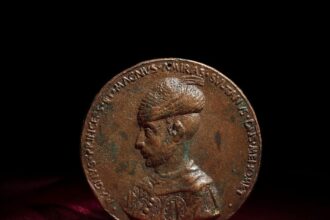Raëlism is a religious movement that has gained attention for its unique beliefs and advocacy in various areas, including sex-positive feminism, genetic modification, and human cloning. The history of Raëlism traces back to the origins of its founder, Claude Vorilhon, who later became known as Raël.
Early Years
The early years of Raëlism revolve around the life of Claude Vorilhon and the encounters that led to the formation of the movement. According to Raëlian Messages, Vorilhon had his first meeting with an extraterrestrial Eloha on December 13, 1973. This encounter took place near an inactive volcano called Puy de Lassolas in France. Two days later, Vorilhon had another meeting with the Eloha, who revealed insignias engraved on their spaceship and spacesuit.
These encounters formed the foundation of Raël’s beliefs and teachings. The Eloha explained that the interlocked triangles in the insignias symbolize “as above, so below,” encapsulating the idea of humanity’s choice between paradise and returning to a primitive stage. Vorilhon was given the name for the religious movement he would establish, which is known as MADECH (mouvement pour l’accueil des Elohim créateurs de l’humanité).
Founding of Raëlism
On September 19, 1974, Claude Vorilhon held his first public conference in Paris, France, attracting over 2000 people. This marked the official founding of MADECH and the beginning of Raël’s mission to spread the Raëlian messages. Raël and his followers aimed to inform the public about their beliefs, including the establishment of geniocracy, humanitarianism, and world government.
To support the dissemination of their message, Raëlian books were published and distributed worldwide in multiple languages. The primary source of Raël’s history and teachings can be found in these books, which are freely available on the internet. Additionally, Canadian sociologist Susan J. Palmer has written extensively about Raël’s struggle to organize the young Raëlian movement, providing valuable insights into its early years.
Middle Years
During the middle years of Raëlism, Raël’s influence expanded globally, and the movement gained momentum in different parts of the world. Raël traveled extensively, spreading his message and attracting followers. In 1980, Raël’s book “Sensual Meditation” was published, marking the formal publication of the Raëlian Messages in the Japanese language and the beginning of the movement’s mission in Japan.
Africa also became a significant focus for the Raëlian Movement during this period. Raël and his followers emphasized the need for a more honest and complete decolonization of Africa, advocating for a “United States of Africa” that would reconnect Africans with their pre-colonial religious and territorial roots. The movement also initiated the Clitoraid project, aiming to provide clitoral repair surgeries for women who had undergone genital mutilation.
Advocacy and Controversy
Throughout its history, Raëlism has been associated with various controversial actions and advocacy efforts. In 1992, Raëlians launched Operation Condom, a project aimed at promoting condom use and advocating for sexual freedom among teenagers. They also organized conferences and events advocating for masturbation and self-love, challenging societal taboos surrounding these topics.
The movement’s advocacy extended to political and social issues as well. In 1994, Raëlians implemented their version of baptism in St. Peter’s Basilica, which led to clashes with the Catholic Church. Raëlism also gained attention in 2002 when Brigitte Boisselier, a Raëlian bishop and CEO of Clonaid, announced the birth of the first human clone, sparking ethical debates and controversy.
Recent Years and Relocation
In recent years, the Raëlian Movement has undergone significant changes and relocations. In 2007, the North American headquarters of the movement was relocated from Quebec to Las Vegas, Nevada. The movement continues to promote its message through various means, including the establishment of museums and participation in events and conventions.
Despite facing criticism and controversies, Raëlism remains a unique and distinctive religious movement. Its advocacy for sexual freedom, genetic modification, and its belief in extraterrestrial Elohim have set it apart from traditional religions. The movement continues to attract followers and generate interest worldwide.
The history of Raëlism is a journey of beliefs, advocacy, and controversy. From its early years, marked by encounters with extraterrestrial Elohim, to its founding and expansion, Raëlism has left an indelible mark on the religious landscape. While the movement has faced criticism and controversy, it continues to advocate for its unique beliefs and principles. Raëlism remains a distinctive and thought-provoking movement that challenges societal norms and promotes a vision of a different future.






















